2010 News
2010 News
Two School of Chemical and Physical Sciences staff win at Welly Awards
26 November 2010
Prof Sir Paul Callaghan and Dr Gillian Turner were named finalists in their categories at the Welly (Wellingtonian of the Year) Awards at the Wellington Town Hall last night.
Gillian won the education category which “celebrates those individuals who may have made education their life’s mission. The education sector makes a huge contribution to Wellington, from preschool right through to tertiary.”
Sir Paul won the Science and Technology category which “lets us recognise the intellectual capital of Wellingtonians, and nowhere does this shine more than in science and technology.” John Watt was also a finalist in this category.

John Spencer, Head of School commented, “I was delighted to see Gillian recognised for her work as an inspirational science communicator, promoting science (and physics in particular) to students and the wider public through her talks, books and activities like the Science Fairs. Paul is also a great communicator, but this award recognises the enormous international and local impact his research has had in the field of magnetic resonance.”
The Wellys had this to say about each of our finalists.
Sir Paul Callaghan is one of the most influential scientists in the country. He’s a world-leader in nuclear magnetic resonance and nanotechnology – real science that’s having a real impact on the world and New Zealand’s place in it.
Dr Gillian Turner has inspired generations of young scientists through her work with science fairs, teaching, student advice and outreach at Victoria University. She has led the judging of the NIWA Wellington Fair since 2004. The publication of her popular science book, North Pole South Pole, further conveys her enormous capacity to captivate her audience, and to engender curiosity and lifelong learning.
Dr John Watt, the star of the TV Science show “Ever Wondered” has been named the top emerging scientist in the Prime Minister’s science awards for his research into reducing vehicle exhaust pollution.
Victoria scientists honoured by their peers
8 November 2010
Victoria University scientists scooped two major New Zealand Association of Scientists (NZAS) awards presented in Wellington last Thursday evening.
Professor Ken McNatty

Professor Ken McNatty, from Victoria’s School of Biological Sciences, received the Shorland Medal, awarded for a major contribution to research that has added to scientific understanding and delivered benefits to society.
Well-known media commentator Dr Marc Wilson, a Senior Lecturer in Psychology at Victoria, received the NZAS Science Communicators Award for 2010.
Victoria University Vice-Chancellor Professor Pat Walsh says the awards reflect the calibre of staff and research at Victoria.
"Across all the scientific disciplines, we have outstanding researchers and teachers who are leaders in their field. These awards are a great honour for Victoria and we are proud of the recipients."
Victoria Professor Ken McNatty (pictured above), a world-leading authority in the study of reproductive biology with 260 plus research papers and ten patents to his name, says it is a particular honour to receive the award.
"I first got to know Brian Shorland when I was based at Wallaceville Animal Research Centre and he came into my office one morning. I’d never met him before that day, but he’d taken the trouble to nominate me for a Royal Society of New Zealand Fellowship which I thought was remarkable and I was very grateful for that. It’s wonderful now to receive the award named in his honour," he says.
The late Brian Shorland was an Honorary Fellow in Victoria’s School of Biological Sciences where Professor McNatty works, and right up until his death in 1999 at the age of 90 came into work nearly every day.
Professor McNatty has done pioneering work on reproduction in sheep and cattle that has had huge economic benefits for farmers. His research in human reproductive biology identified how healthy eggs are produced at ovulation and his current work is focussed on identifying how to select healthy eggs for human in vitro fertilisation (IVF).
Dr Marc Wilson
Having a psychologist named best science communicator for 2010 is a particular thrill for Dr Wilson (pictured right) who says he comes from a discipline that is often marginalised.

"It’s so cool to see the science of psychology being recognised. At best it’s seen as soft and, at worst, touchy, feely and unempirical. Often when I am talking at information evenings or out in the provinces and I say I’m representing the Faculty of Science, people look doubtful.
"In fact all areas of science, including psychology, share the use of scientific method and evidence to test our theories in the world."
Dr Wilson has wide ranging research interests around applying psychological theory to important social issues. This includes political preferences, national identity, food preferences, religion and people’s beliefs about paranormal phenomena.
As well as commentating on social issues, Dr Wilson delivers public lectures on aspects of his research and researched, co-wrote and presented two television series—School of Home Truths, which examined how our personalities influence the real estate decisions we make, and School of Success, which focused on the mindset needed to succeed. In 2005, Dr Wilson won a Victoria University Excellence in Teaching Award and, in 2008, became the first psychology teacher in New Zealand to receive a National Teaching Excellence Award.
Dr Shaun Hendy
In addition, the NZAS Research Medal went to IRL’s Dr Shaun Hendy, Deputy Director of the MacDiarmid Institute for Advanced Materials and Nanotechnology which is based at Victoria. The medal is awarded to a scientist under 40 for publishing outstanding fundamental or applied research in their field.
Extended - Summer Scholars Scheme
21 September 2010
The Faculties of Science, Engineering, Architecture & Design still have some Summer Scholarships available for the summer trimester, 2010-2011.
Students partner with academic staff to conduct a research project and receive a $7,000 scholarship, paid in three instalments, which is jointly funded, half by the University Research Office and the other half organised by the academic staff member concerned. A number of specified projects offered in association with Industrial Research Limited and the MacDiarmid Institute are also available for application.
Staff have until the end of September to lodge an application. The list of projects and application forms are available from the Faculty of Science Scholarships webpage.
Ever Wondered? Local TV series fronted by John Watt
18 August 2010
Ever Wondered? is a 10-part TV series that takes a celebratory look at the cutting edge scientific research being performed in New Zealand. Each week is dedicated to a particular topic such as astronomy, functional foods, sports science and technology in medicine.
Dr John Watt, from the School of Chemical and Physical Sciences is the MacDiarmid Young Scientist of the Year and winner of the Prime Minister’s MacDiarmid Emerging Scientist Prize. John’s role as host is to interview the researchers, showcase the advances and discoveries they’ve made and relate the scientific story to the viewer throughout the series.

“I’m honoured to be involved with something that is really pushing the promotion of science and technology in this country. And to be able to travel the country meeting outstanding researchers and sharing their enthusiasm for their work is pretty special,” says John.
Although the programme is focused on New Zealand research, it also includes local projects with international collaborations. “One of the most surprising things about filming the series was discovering the huge range of fields in which we lead the world. I always knew that we had a strong research base in New Zealand, but finding out the scale of different projects where we truly are world class in has left me in awe.”
Drs Melanie Johnston-Hollitt and Denis Sullivan, Kerstin Burridge and Prof Jim Johnston also from the School of Chemical and Physical Sciences, feature in later programmes.
Sponsored by the Royal Society of Royal Society of New Zealand, the series is part of TVNZ 7’s Spotlight on Science and Technology Month in August, which is partnered by the Ministry of Research, Science & Technology. The sponsors’ aim is to bridge the gap between the world leading scientific research being performed locally and the interested public.
Ever Wondered? began on August 7 and screens on Saturdays at 6.10pm and 10.35pm and Sundays at 12.35pm. Previews and previous episodes are available from the TVNZ 7 website.
Victoria lecturer one of New Zealand’s best
6 August 2010
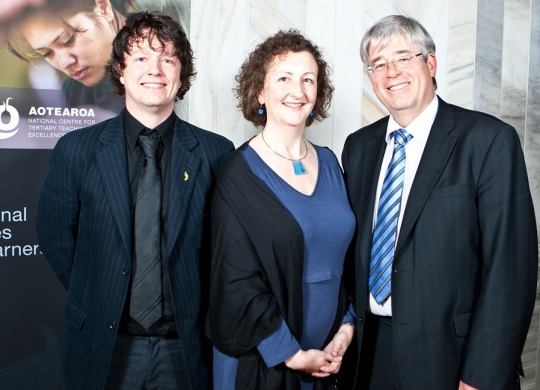
Victoria University Senior Lecturer Sara Kindon is officially one of New Zealand’s top teachers—winning a 2010 AKO Aotearoa Tertiary Teaching Excellence Award at Parliament on Wednesday.
Ms Kindon teaches in Human Geography and Development Studies and uses innovative and research-led approaches to challenge and encourage her students.
At the beginning of one of her postgraduate courses, Young People and Participatory Development, students encounter a high ropes adventure course where they learn to trust their teammates and work with each other off campus. Overcoming fears and building confidence then contributes to collaborative research with young people in Wellington throughout the rest of the course.
“I describe my teaching philosophy as one that is committed to unsettling learners’ assumptions about Geography and Development Studies,” says Ms Kindon.
Evidence suggests this approach brings results. Research carried out through this course has received national recognition from the Human Rights Commissioner for its contribution to positive race relations.
In her other postgraduate course, Geography of Place, Power and Identity, students lead experiential fieldtrips for each other. These engage students in contemporary theories about space and place in different sites in Wellington.
Currently completing her doctoral thesis, she will resume her postgraduate teaching next year, as well as teaching an undergraduate course—Race, Gender and Development—with Dr Jessica Hutchings (Ngai Tahu, Ngati Huirapa).
Ms Kindon has successfully supervised 59 postgraduate students since her appointment in 1994 and has published 12 quality-assured articles and book chapters on aspects of the teaching-research nexus.
A 2008 winner of a Victoria University Award for Sustained Excellence in Teaching, Ms Kindon reserves special mention for Global Remix, a student-led support group she helped to establish for students from refugee backgrounds at Victoria.
“Working with courageous and insightful students, supportive colleagues, and communities in all their diversity are privileges I relish every day.”
Experts explore supervolcanoes and Pompeii
5 August 2010
Two Victoria University experts are visiting New Plymouth to speak about supervolcanoes and the discovery of an ancient Roman city at Pompeii preserved by a volcanic eruption.
New Plymouth residents—who live near the active but quiet volcano, Mt Taranaki—will have the opportunity to hear from Professor Colin Wilson from Victoria’s School of Geography, Environment and Earth Sciences and Classics lecturer Dr Matthew Trundle on Tuesday 10 August.
Professor Colin Wilson studies the volcanoes that produce the biggest eruptions: supervolcanoes.
"The most recent eruption from a supervolcano was in New Zealand—at Taupo, 26,500 years ago. It ejected 1,170 cubic kilometres of material and caused several hundred square kilometres of surrounding land to collapse, forming a hole in which Lake Taupo formed."
In comparison, the biggest volcanic eruption in recorded history—the 1815 eruption at Tambora in Indonesia—ejected only 150 cubic kilometres of pumice and ash yet the explosion was heard 2,000 kilometres away, and the eruption and its effects killed at least 71,000 people.
"We've never experienced anything on the scale of a supervolcano," says Professor Wilson, one of the world’s leading volcanologists.
"I’ve been close enough to erupting volcanoes to take photos of the eruption but with supervolcanoes we’re talking about eruptions where if you see it, you’re dead."
His talk, titled ‘Supereruptions: all you wanted to know but were afraid to ask’, is followed by the second part of the lecture on the discovery and excavation of the Roman city, Pompeii, which was buried by the eruption of Mt Vesuvius in 79 AD.
"Pompeii is a window into the Roman world yielding fascinating insights for historians," says Dr Trundle, who worked on archaeological sites on the Greek mainland before coming to New Zealand.
"As well as being a history of Pompeii, the lecture’s a history of archaeology. In many respects, the site over the years has reflected the times, from gentlemen ‘looting’ ancient artworks during the age of the Grand Tour, to Mussolini’s Roman revival through to the systematic analysis we see today."
Dr Trundle says that only two thirds of Pompeii has been cleared so there is plenty of potential for future discoveries.
"Although we’re more careful excavating than in the past, which is consequently slower, scientific analysis has helped immensely with dating and excavating objects," says Dr Trundle.
"In 50 years’ time, who knows how much more we’ll have found."
The two-part lecture will be presented at the New Plymouth International Hotel & Conference Centre on Tuesday 10 August from 5.30-8.30pm.
The lecture is part of a series of free public lectures in provincial centres from Victoria University’s Faculty of Science.
Prime Minister opens Alan MacDiarmid Building
26 July 2010
The Prime Minister, Rt Hon John Key, officially opened Victoria’s new Alan MacDiarmid Building on Wednesday evening.
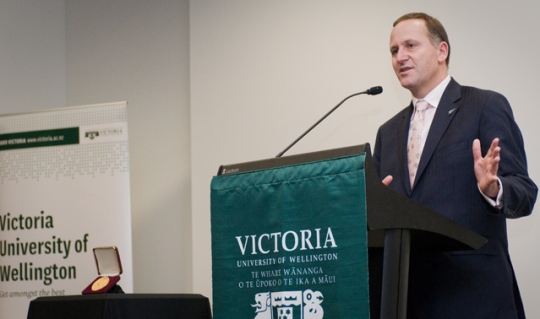
The University invested in the Alan MacDiarmid Building so that staff and students can focus more on research and specialised teaching in the sciences.
The building is named after Victoria alumnus and Nobel Prize-winner, the late Professor Alan MacDiarmid. Along with two colleagues, he won the Nobel Prize for Chemistry for discovering that plastics can be made to conduct electricity. His research resulted in a number of smart, everyday uses such as cell phone displays.
Vice-Chancellor Professor Pat Walsh said the University built the Alan MacDiarmid Building to continue Victoria’s world-class work in the sciences.
Alan MacDiarmid’s Nobel Medal will be displayed in the building after the medal and other memorabilia was donated by his family.

“By housing the medal here in the Alan MacDiarmid Building, it will hopefully inspire the students and staff that study and work here each day, to follow in his footsteps,” says Professor Walsh.
More than 150 guests attended the opening including the Prime Minister, Hon Dr Wayne Mapp, Minister for Research, Science and Technology, Hon Steven Joyce, Minister for Tertiary Education; and members of the MacDiarmid Family, including Alan’s widow Gayl Gentile.
Dr Melanie Johnston-Hollitt chosen as 2010 Royal Society Hudson Lecturer
16 July 2010

The Hudson Lecture is the Royal Society of New Zealand, Wellington branch's premier annual lecture. The Hudson Lecturer is awarded in recognition of their effort in science or the promotion of science and technology. Melanie Johnston-Hollitt is a senior lecturer in the School of Chemical and Physical Sciences.
In the lecture, Dr Johnston-Hollitt presented an overview of radio astronomy and discussed plans for next generation of telescopes. She also discussed research into galaxy clusters - the largest gravitationally bound objects in the Universe.
“I was very honoured to be selected as the 2010 Hudson Lecturer. Although famed primarily as an entymologist with a particular fondness of butterflies, Hudson was an outstanding example of someone with a passion for science in general”, says Melanie.
“George Hudson showed that even 100 years ago someone in New Zealand could make observations of the sky and contribute via international networks to the discovery of new astronomical objects.
“Now, in this new century, we find that in order to take science forward we need to change how science is done, and work in large, multi-disciplinary, international teams. With projects as vast and complex and the Square Kilometre Array, we also need to re-define who can contribute. It no longer matters where you are from - people from all over the world will make discoveries and lead the science of the next century.
“And it's not just the ‘scientists’ - the public have an exciting and important role to play and we are already seeing astronomy as a champion of citizen science.”
North Pole, South Pole, a new book by Dr Gillian Turner launched
28 June 2010

Why does the compass needle point north? What actually causes magnetism, which Albert Einstein described as one of the last great unsolved mysteries of physics?
A new book by Victoria lecturer Dr Gillian Turner tells an amazing true story that reads like science fiction.
In the book, she describes how scientists struggled for centuries to understand Earth’s magnetism—from ancient Greeks fascinated with magnetised rocks to modern geophysicists who finally discovered the truth—including the almost unbelievable finding that every million years or so Earth’s magnetic field does a complete flip.
North Pole, South Pole provides an extraordinary window into science, passion and the brilliance of the human mind. For Dr Turner, it is the culmination of a dream.
“It’s hard to imagine a more exciting science story,” she says. “Ever since I first became interested in Earth’s magnetic field, I’ve thought it would make a terrific book—and not just for people interested in science. It’s really a story about human curiosity, and people obsessed with cracking a mystery.”
North Pole, South Pole was launched last Thursday at a function in the Alan MacDiarmid Building attended by the Vice-Chancellor, Professor Pat Walsh, and the Dean and Pro-Vice-Chancellor of Science, Professor David Bibby.
In a speech, Professor Sir Paul Callaghan commended Dr Turner for taking on the challenge of communicating her specialist subject to a general audience.
He also described his own fascination with the compass, urging all children to be given one, to encourage them to become “thinkers”.
The book launch was hosted by Awa Press, who published the book, the Faculty of Science, The Royal Society of New Zealand and vicbooks.
Read more about the book and how to obtain a copy.
Victoria offers fellowships to Chilean scientists
24 May 2010
To ensure scientific research can continue following the devastating earthquake in Chile, Victoria University is offering six four-month fellowships to Chilean scientists.
"Scientists have lost samples they had been collecting for many years, and we understand that in some cases whole collections that are important to the ecosystem in Chile have been lost," says Deputy Vice-Chancellor (Research) Professor Neil Quigley.
"Some facilities need to be entirely rebuilt, particularly those on the coast that were affected by the tsunami."
The visiting fellowships are open to academic staff members of Chilean universities or research institutions whose laboratory facilities are unusable following the earthquake, and will provide funding to cover a round trip airfare and accommodation in Wellington for four months.
Universities most affected are in the central and southern part of the country, including the University of Concepcion, La Frontera University in Temuco, universities in the cities of Talca, Curico and a number of coastal marine field stations.
Professor Quigley says that the fellowship recipients will be teamed up with Victoria scientists who are conducting similar work to enable them to continue their research.
"We have had strong links with Chilean universities for some time now, and this is our way of acknowledging that relationship and ensuring that important research in Chile continues.
"Being part of an international research community, it's important to ensure that long term gains aren't jeopardised by unforeseen events such as this."
Applications for the Visiting Fellowships should be sent to the Office of the Dean of Science at science-faculty@vuw.ac.nz by 30 July.
For more information, please contact Senior Communications Adviser Tania Guenter, by email tania.guenter@vuw.ac.nz or phone (04) 463 5269.
Honour for Liz Richardson
10 May 2010
Liz Richardson was recently presented with her Queen's Service Medal (QSM) for services to Māori and Pacific Islands education at a special ceremony at Te Puni Kokiri, the Ministry of Māori Development.
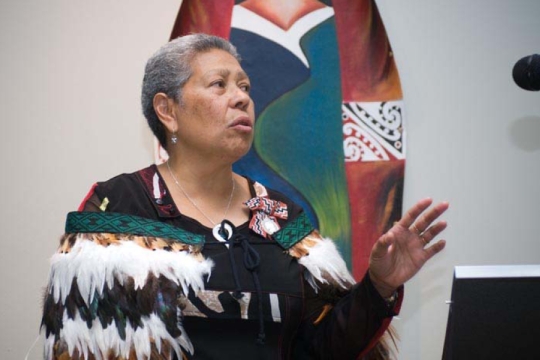
Liz is Deputy Dean (Equity) in Victoria's Faculty of Science and was awarded the honour in the New Year Honours.
At Victoria, she has helped establish Te Ropu Awhina, the on-campus whanau for students in the Faculties of Science, Engineering, and Architecture and Design, which celebrated its 10th birthday last year.
Since 1999, Awhina has helped produce a Māori academic science staff member and students have won $4.6m of scholarships, $4.1m of which was nationally contested. A total of 691 students have completed their degrees, including seven with PhDs.
Victoria and IRL bringing business to science.
22 April 2010
Victoria University and Industrial Research Limited (IRL) are working to foster entrepreneurial and commercial skills among New Zealand's emerging scientists.
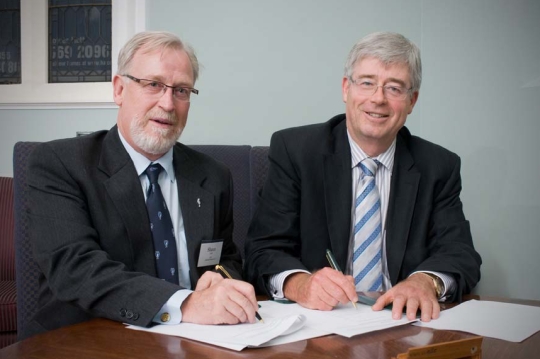
IRL has established PhD scholarships at Victoria which will help ensure that the next generation of scientists can commercialise their research and help lift New Zealand's economic performance and prosperity.
Professor Pat Walsh, Vice-Chancellor of Victoria University, says the initiative builds on the existing collaboration between the two organisations. "Victoria has an excellent, collaborative relationship with IRL and these scholarships strengthen that mutually beneficial partnership.
Both Victoria and IRL have close links with other science organisations in Wellington. Here, we're at the heart of science in New Zealand."
The IRL PhD Scholarships in Science or Business at Victoria University will assist postgraduate students in Victoria's Faculties of Science, Engineering and in the Faculty of Commerce and Administration, namely the Victoria Management School.
There will initially be four scholarships each worth $25,000 a year for up to three years. Recipients will work on a thesis of direct relevance to one or several of IRL's research programmes. The scholarships were established through the Victoria University Foundation.
Shaun Coffey, IRL Chief Executive, says collaboration between universities and crown research institutes can provide synergies for both organisations.
"IRL strives to transform scientific endeavour into commercial outcomes that support New Zealand industry. Through these scholarships Victoria University's acknowledged expertise in both science and business will assist us in our mission."
Last year Victoria and IRL signed a Memorandum of Understanding on the supervision of postgraduate students.The collaboration will assist students with research in areas such as carbohydrate chemistry, high temperature superconductors, energy and materials, engineering and applied physics, integrated bioactive technologies, measurement standards, nanotechnology and photonics.
Podcast - Erosion on a rocky coast
22 April 2010
David Kennedy, from the School of Geography, Environment and Earth Sciences talks to Alison Ballance of Our Changing World, Radio New Zealand National, about the erosion processes on Wellington's south coast.
Prestigious international award for eminent Victoria University scientist.
16 April 2010
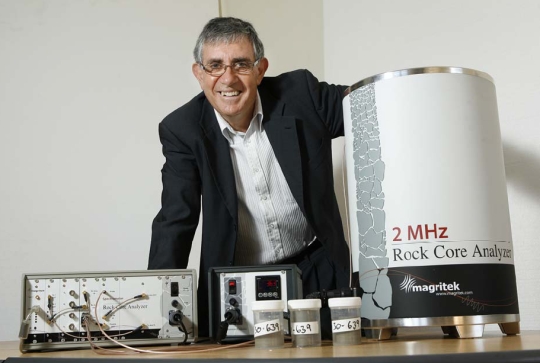
Innovative research resulting in millions of export earnings for New Zealand has landed Victoria University physicist Professor Sir Paul Callaghan a major international award."Blown away" was the reaction of Professor Callaghan on hearing he had won the prestigious Gunther Laukien Prize for Magnetic Resonance.
The award is given for "cutting edge experimental nuclear magnetic resonance (NMR) research with a high probability of enabling beneficial new applications".
"My work in nuclear magnetic resonance essentially uses radio waves to detect the motion of molecules," says Professor Callaghan.
"The exciting thing is that we've now got a New Zealand company - Magritek - exporting NMR technology overseas. Although NMR technology probably doesn't mean a lot to most people, the young company has 16 employees and revenue in the millions.
"The way I see it, if the general public is familiar with the things being manufactured in the high tech sector, we're probably trying to produce the wrong things.
"New Zealand is not going to be making flat-screen TVs. Our future is in high tech, niche markets and that's how we'll ensure that the New Zealand we know and love is still here tomorrow."
The prize was announced on 19 April at the annual Experimental Nuclear Magnetic Resonance Conference at Florida in the United States. Unfortunately, Professor Callaghan was unable to receive the award in person because he is undergoing chemotherapy for cancer.
The prize was accepted on his behalf by a past PhD student, Dr Andrew Coy, now CEO of Magritek, a spin-out company from the MacDiarmid Institute for Advanced Materials and Nanotechnology based at Victoria University. Professor Callaghan was the Institute's founding Director.
"It's an honour to be included with previous winners who are some of the world's top people in the field," says Professor Callaghan.
The Vice-Chancellor of Victoria University, Professor Pat Walsh said that Professor Callaghan's award was well-earned.
"In recent years, his work has broadened to raise awareness on how to lift New Zealand's prosperity through research and technology. At heart though he remains a dedicated scientist and I am delighted that his illustrious career has been recognised in this way."
About the prize.
The Gunther Laukien prize was established in 1999 to honour the memory of Professor Gunther Laukien, the co-founder of Bruker Corporation. The prize is worth US $20,000.
It is awarded annually by a prize committee chaired by Nobel Laureate Professor Richard Ernst of the university, ETH Zurich.
Staff Excellence Award for Antarctic Research Centre administration team
12 April 2010
The Antarctic Research Centre's managerial and administrative team of Tamsin Falconer and Michelle Dow has provided outstanding service that has contributed directly to the excellent research performance and profile of the Centre over the last two years.
Tamsin is recognised for her high-level development and maintenance of key relationships and contracts with internal and external partners and stakeholders, her role in the development and management of the Science Drilling Office, and her management of research contracts, centre finances and endowed funds.
Michelle makes an outstanding contribution to the development of promotional and information products such as the Centre's website and newsletter, and the coordination of workshops, conferences and events.
Together this team has helped raise the performance and profile of the Antarctic Research Centre and, in a broader sense, the research profile, prestige and excellence of the University.
Victoria Professor becomes Honorary Engineering Fellow
22 March 2010
Professor Sir Paul Callaghan has been elected an Honorary Fellow of the Institution of Professional Engineers of New Zealand (IPENZ) in recognition of his eminent contribution to application of engineering or technology in the community.
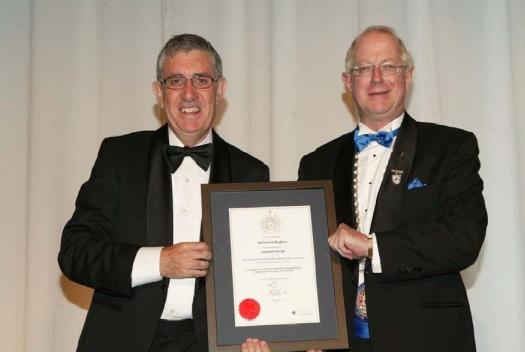
In its annual awards on Friday evening, IPENZ recognised his contribution for explaining to the public, business leaders and politicians the way in which engineering and science need to work together to create the high technology industries to increase New Zealand's prosperity.
Sir Paul has had an outstanding career in science; he was made a Fellow of the Royal Society of London and received the 2005 Rutherford Medal and the 2007 Blake Medal for leadership.
He is internationally recognised for his work in establishing the MacDiarmid Institute of Advanced Materials and Nanotechnology; however, it is Sir Paul's work in technology development that earned him the title of Honorary Fellow.
He played a fundamental role in leading the establishment of New Zealand's performance-based research funding system for tertiary institutions. In his book Wool to Weta: Transforming New Zealand's Culture and Economy, Sir Paul emphasises the need for engineering and science to work side by side and he has become a powerful advocate for the engineering, technology and science communities, through public presentations, and behind the scenes work with government. "This Honorary Fellowship reflects the high esteem in which the engineering profession holds Sir Paul," says IPENZ Chief Executive, Andrew Cleland.
New Alan MacDiarmid Building nears completion
17 March 2010
Construction work on the new building is now in its final stages, in preparation for the official opening in July.
Project Manager, Ian Maskell said it had been a challenging building project due to the specifications of the various environments in the building. It had stretched the design and engineering team to supply the specialised elements in a cost-effective way that also complied fully with all building standards.
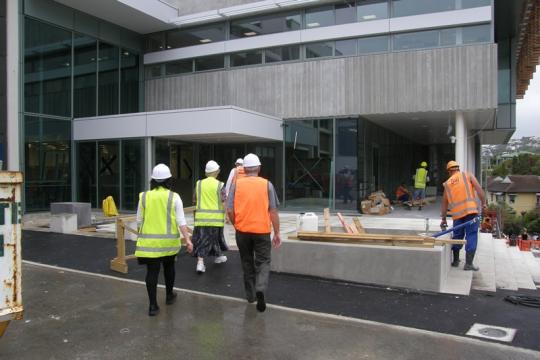
The building will provide much needed teaching, office and lab space for the Schools of Biological Sciences and Chemical and Physical Sciences, and computer labs for the School of Engineering. It will link Cotton and Laby Buildings at both ground and first floor level and have a Wishbone cafe. The top floor is a "churn space" to provide temporary accommodation for staff while other building areas on campus are refurbished in the next 3-5 years.
The building is spacious and light inside with an open foyer and staircase to level 2. Level 1 comprises six teaching or seminar spaces with two designed with flexibility to accommodate groups of different sizes. The building has been designed with accessible infrastructure so that changes to meet technology improvements can be made with minimal disruption.
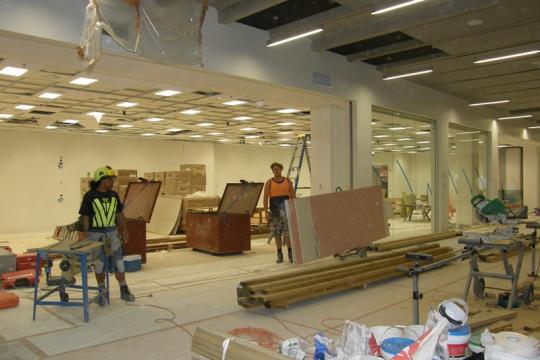
Energy efficient features have been incorporated into the design. The lighting system has sensors to adjust light levels with changing occupancy and natural lighting levels. The west and east elevations of the building have sun shading louvers. An "eyebrow" (a strip of solid wall) on the outside of the north side of the building minimises direct sunlight and radiant heat onto workstations in the write up areas, but glass beneath the eyebrows enables people to see out when seated.
When windows are opened for natural ventilation, the air conditioning system automatically shuts off to save energy. Solar panels on the roof support the heating system and heat is recovered from the return air system to further reduce energy costs.
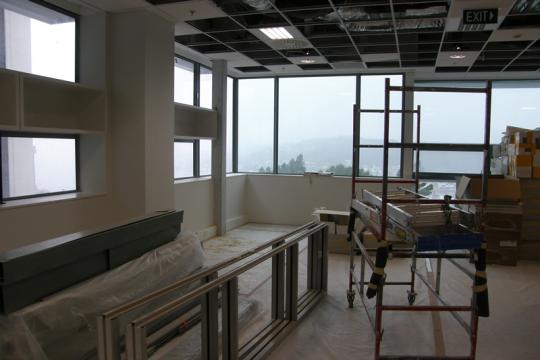
Construction was carried out in a novel way to minimise noise on site, in consideration of the site's proximity to adjacent buildings. All concrete apart from the floor was pre cast in Hawke's Bay and trucked onto site.
The concrete columns were erected in a single lift, three stories high. Beams were dry jointed to the columns and the floor section laid on top before any concrete was poured.
Joints are established using a steel connection and damper system that hold the structure under tension, ensuring it will return to a vertical position after a seismic event. The damper steel components are designed to absorb shock in an earthquake instead of the concrete, and then be replaced easily if damaged. A video explaining the structural system and building construction will be available on a portal in the new building.
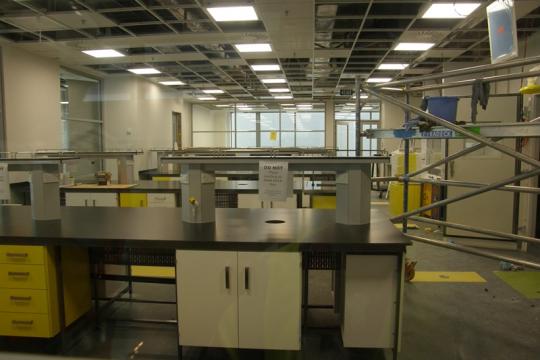
Victoria student awarded Prime Minister’s Science Prize
16 March 2010
Victoria University PhD student John Watt has received a Prime Minister’s Science Prize, New Zealand’s most valuable science awards.
The prize was among five awarded last Tuesday. The prizes were introduced in 2009 to raise the profile and prestige of science among New Zealanders. They combine recognition and reward, with total prize money of one million dollars.
Mr Watt won the Prime Minister's 2009 MacDiarmid Emerging Scientist prize worth $150,000. He was also the winner of the 2009 MacDiarmid Young Scientist of the Year title.
His work into nanoparticles which improve air quality by reducing toxic vehicle exhaust emissions has been boosted with $100,000 of prize money to be used for further research and commercialisation.
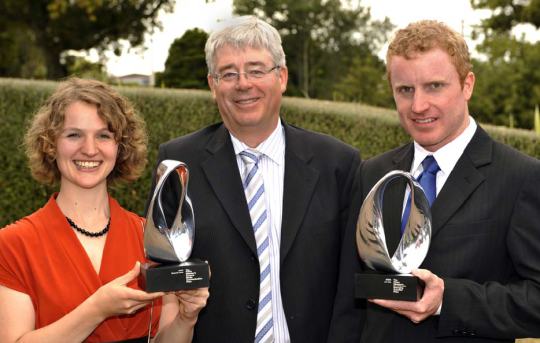
Victoria University Vice-Chancellor Professor Pat Walsh says that John Watt’s success is an example of research excellence at Victoria and of the superb teaching and support of his supervisor, Dr Richard Tilley.
"John’s research is at the cutting edge. He is a true scientist—curious, hard working and committed. I’m proud that his accomplishments have been recognised at the highest level."
Two other prize winners have strong Victoria connections.
"It's impressive to note that, not only are there strong Victoria connections amongst the prize winners, but that four of the five prize winners are from Wellington," says Professor Walsh.
The Prime Minister's Science 2009 Communication Prize will give Victoria alumna Elizabeth Connor (pictured above with Vice-Chancellor Professor Pat Walsh and John Watt) the opportunity to help change attitudes to science and encourage a greater understanding of the contribution science makes to the country.
She was encouraged into the field by Victoria Professor Sir Paul Callaghan and her prize provides $150,000 to further develop her knowledge of science media communication.
Dr Jeff Tallon, a former staff member in the School of Chemical and Physical Sciences, who still works with the MacDiarmid Institute based at Victoria University, was a joint winner of the premier Prime Minister’s Science Prize.
Dr Tallon and Dr Bob Buckley have led Industrial Research Limited's (IRL) superconductor research and commercialisation activity for 20 years. Drs Buckley and Tallon receive prize money of $500,000, with $400,000 for continued development of high temperature superconductors technology at IRL.
Take a Look at Science - new promotional DVD for the Faculty of Science
19 February 2010
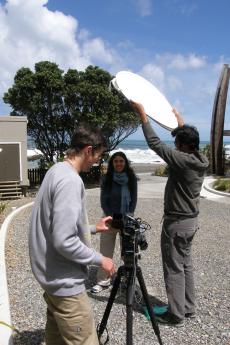
The Faculty of Science has produced a new promotional DVD featuring the exciting research being undertaken by staff and students at Victoria University. It is fronted by John Watt, the MacDiarmid Young Scientist of the year, 2009.
The DVD was filmed over four days both on and off campus, with venues including the Victoria University Coastal Ecology Lab (VUCEL) in Island Bay, the GNS Science ice core research facility in Lower Hutt, Otari-Wilton's Bush and Sidhe Interactive, New Zealand's biggest computer game developer.
"It was really exciting to showcase some of the great science that's going on at Victoria, and to see our staff and students talk about their work in such a confident way, says Sarah Wilcox, DVD producer.
"It's a very funky production that we hope will appeal to school students thinking of studying science at tertiary level."
The DVD is available in two versions - a full 15 minute version that will be distributed to high schools nationwide and a three minute version that is available on the Faculty website.
Please contact us to request a free copy of the longer version.
